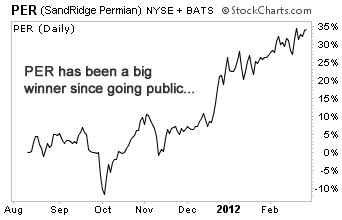
Only about two dozen of these securities exist… but double-digit yields are common.
I first uncovered this asset class years ago, back when I started my High-Yield Investing advisory in 2004. In October of that year, I added one of these securities to my portfolio at $41.33. I sold it for $64.51 about two years later. Along with $9.93 in distributions, my total returns were just over 80%.
Another one of these rare investments has also done well for current High-Yield Investing subscribers. I added it to my portfolio in late October 2010. I’ve received $4.28 per unit in distributions and the price has soared. So far, total returns are more than 50% in just 16 months.
I like to return to investment ideas that have done well for me. So it comes as no surprise that I’m again looking into one of the highest-yielding, yet rarest, income investments on the market — royalty trusts.
These trusts are designed for one thing: to pay out royalties, or a share of production revenues, from a field of existing oil and natural gas wells.
The first trust debuted in 1979. Amazingly, even after more than 30 years there are still only about two dozen publicly traded oil and gas royalty trusts. And between 1999 and 2007, no new royalty trusts were created.
But in the past year, there has been a small renaissance in royalty trusts. I count four new trusts that have come to market in the last two years alone.
For income investors, the sudden surge of interest is good news. Routinely providing yields of about 10% or more, royalty trusts can seem too good to be true. Why, then, are oil and gas companies spinning off properties into publicly traded trusts?
Money.
Trusts allow the parent company to get full value for their reserves while also raising money, without diluting their common shares or going further into debt.
But there is one potential hang-up. By definition, these new trusts don’t have an established track record of generating cash flow from their reserves. Instead, you must rely on the company’s production projections and price assumptions, as stated in the prospectus.
That’s the downside. But it’s offset by at least two benefits.

First, recent trusts are being formed for a set life or “term” of 20 years. For example, SandRidge Permian Trust (NYSE: PER) was formed on May 12, 2011, and will dissolve by March 31, 2031. The parent company or sponsor endows the trust with proven reserves that have high-probability development opportunities to ensure the term is fulfilled.
In contrast, many older trusts formed in the early 1980s have consumed much of their original reserves. Although new production technologies have allowed them, in some cases, to draw more production from their reserves than originally anticipated, they still have a much shorter remaining reserve life. The average reserve life for older royalty trusts is about 8.3 years, versus 20 years for some of the newer trusts.
Once the reserves are used up, a trust expires and any remaining assets are distributed to unitholders. It can’t issue equity or debt to acquire new reserves.
A second benefit is some new trusts have created “subordinated units.” (Royalty trust shares are called units.) These units, which are held by the trust’s sponsor, support the distribution rate to common unitholders.
They work like this. When SandRidge Permian was created, sponsor SandRidge Energy (NYSE: SD) set aside 25% of the outstanding units for itself as subordinated units. These units are also entitled to receive distributions… with a catch.
The trust forecasts target distributions for several years in advance, based on projections of production volumes, commodity prices, the effect of hedges, expenses and taxes.
Then a subordination threshold is also established. For the SandRidge Permian Trust, the threshold is 20% below the target distribution. If the distribution ends up being less than the subordination threshold, the sponsor will make up the difference by reducing or foregoing the distribution on subordinated units. This way, there is some assurance that distributions will reach a pre-determined level should commodity prices fall.
In return, if the distribution is substantially higher than the target, the subordinated shares will receive an extra share of distributions.
These subordinated shares don’t last forever. The parent company retains these subordinated shares until new wells that the trust is also required to drill are completed. Then, a year later, the subordinated shares convert to common shares.
Now before you dive into any trust, there is plenty more to know. Taxes are a little trickier than with a common stock, and trusts will perform differently based on their hedging programs and their production mix of oil and natural gas (I detail all of this in my March issue of High-Yield Investing).
However, if you’re looking for a place to still capture high yields when interest rates are near zero, this sector may be small, but also holds plenty of promise.
[Note: If you’re interested in royalty trusts, be sure to learn more about StreetAuthority’s Top 5 Income Stocks for 2012 report. One stock we’ve selected is a royalty trust yielding double digits… another yields 8.8% and returned 13% during the bear market (when the S&P 500 fell -57%)… and a third holds stakes in dozens of infrastructure monopolies and has has paid more than 90 consecutive dividends. Visit this link to learn more.]
Good Investing!
![]()
Carla Pasternak’s Dividend Opportunities
Disclosure: Neither Carla Pasternak nor StreetAuthority own shares of the stocks mentioned above. In accordance with company policies, StreetAuthority always provides readers with at least 48 hours advance notice before buying or selling any securities in any “real money” model portfolio. Members of our staff are restricted from buying or selling any securities for two weeks after being featured in our advisories or on our website, as monitored by our compliance officer.













